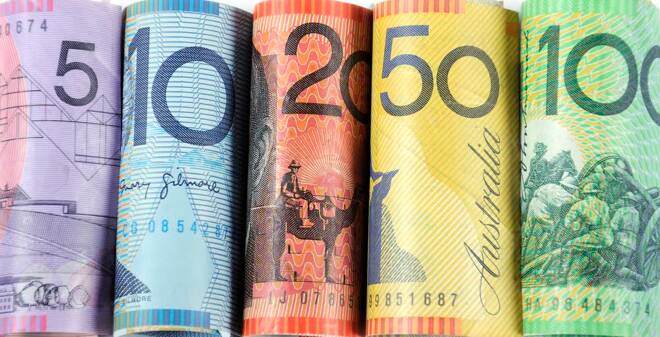Advertisement
Advertisement
AUD/USD Forex Technical Analysis – Longer-Term Bullish Over .6451, Bearish Under .6271
By:
Based on the April 30 close at .6509, the direction of the AUD/USD during May is likely to be determined by trader reaction to the short-term Fibonacci level at .6451.
The Australian Dollar closed sharply higher in April, helped by a spike in demand for higher risk assets as global shares rose to near pre-pandemic levels. One of the catalysts driving the price action was the government’s determination to exit the lockdown that has devastated the economy.
Westpac senior economist Sean Callow said the currency has a close correlation to Wall Street. The S&P 500 “is probably the most important measure of global risk appetite and it looks as though the Australian Dollar once again, after all these decades, is still the most preferred barometer of risk appetite in the currency markets,” he said.
In April, the AUD/USD settled at .6509, up 0.0366 or +5.96%.
The advance in the Australian Dollar is equally connected to the size of Australia’s direct fiscal response by the government to the pandemic, which is so far equivalent to about 10 percent of GDP and one of the largest of the Group of 10 economies, according to Commonwealth Bank. Monetary stimulus from the Reserve Bank of Australia (RBA) also contributed to the impressive gains.
Long-Term Technical Analysis
The main trend is down according to the monthly swing chart. A trade through .7032 will change the main trend to up. A move through .5510 will signal a resumption of the downtrend.
The short-term range is .7032 to .5510. Its retracement zone at .6271 to .6451 was straddled throughout April.
The main range is .8135 to .5510. Its retracement zone at .6823 to .7132 is resistance. Since the trend is down, sellers are likely to show up on a test of this zone.
Long-Term Technical Forecast
Based on the April 30 close at .6509, the direction of the AUD/USD during May is likely to be determined by trader reaction to the short-term Fibonacci level at .6451.
Bullish Scenario
A sustained move over .6451 will indicate the presence of buyers. If this move creates enough upside momentum then look for a rally into a downtrending Gann angle at .6632.
Overcoming .6632 will indicate the buying is getting stronger. This could lead to a resistance cluster at .6823 to .6732.
Bearish Scenario
A sustained move under .6451 will signal the presence of sellers. If this generates enough downside momentum then look for the selling to possibly extend into the short-term 50% level at .6271.
A failure to hold above .6271 will indicate the selling is getting stronger. The next downside target is a steep downtrending Gann angle at .6232. Crossing to the weak side of this angle will put the AUD/USD in a bearish position.
About the Author
James Hyerczykauthor
James Hyerczyk is a U.S. based seasoned technical analyst and educator with over 40 years of experience in market analysis and trading, specializing in chart patterns and price movement. He is the author of two books on technical analysis and has a background in both futures and stock markets.
Advertisement
